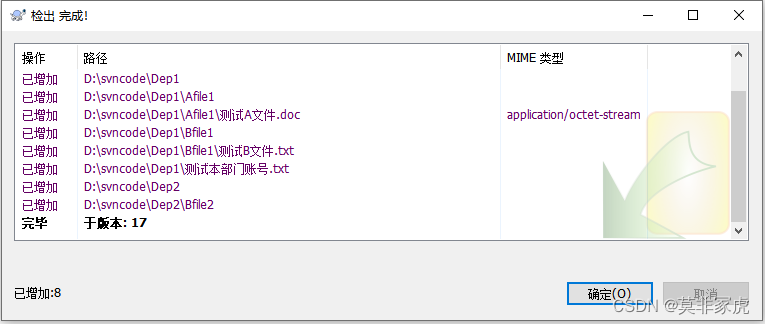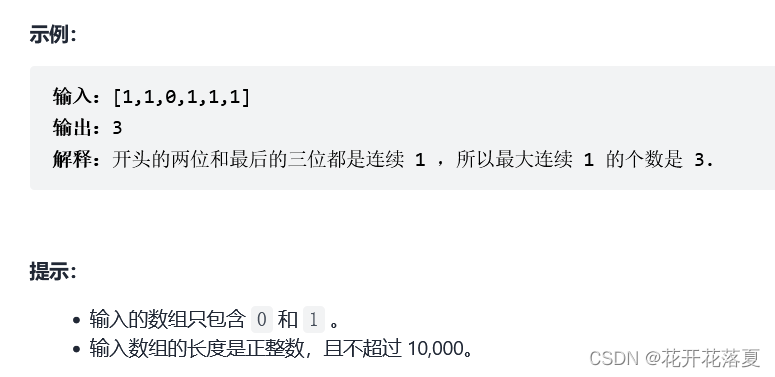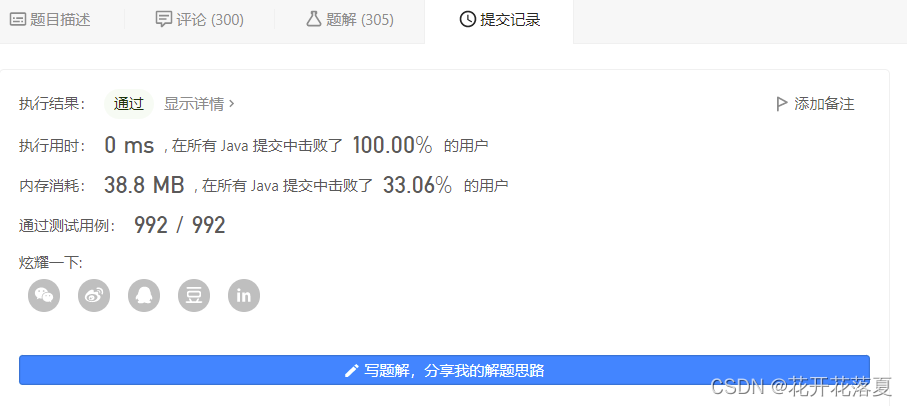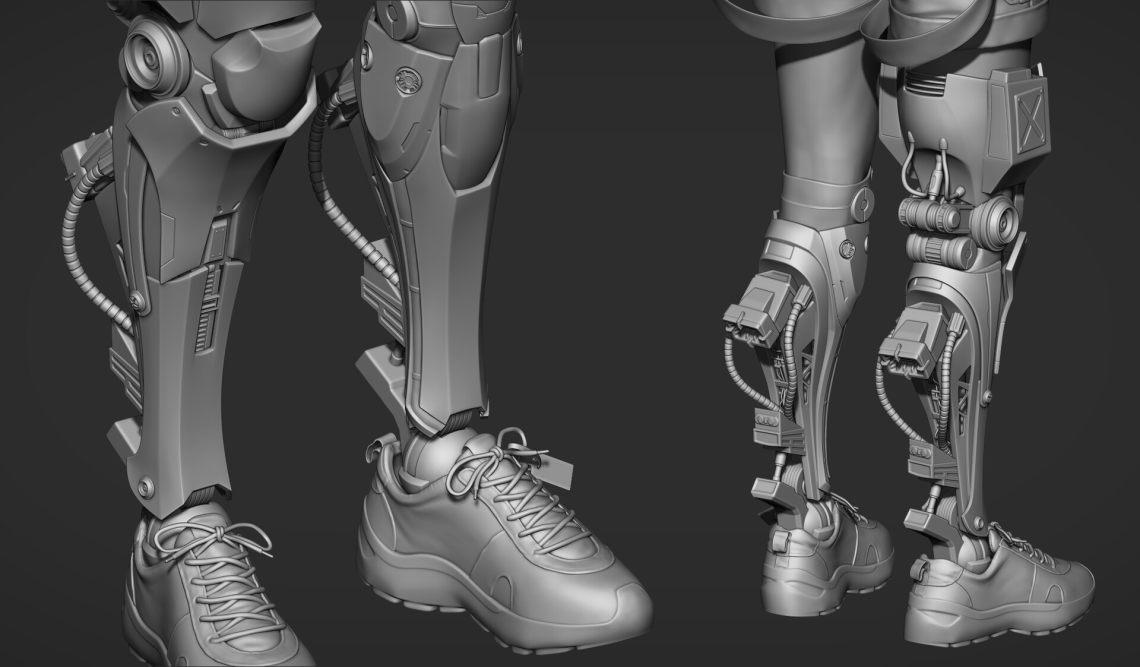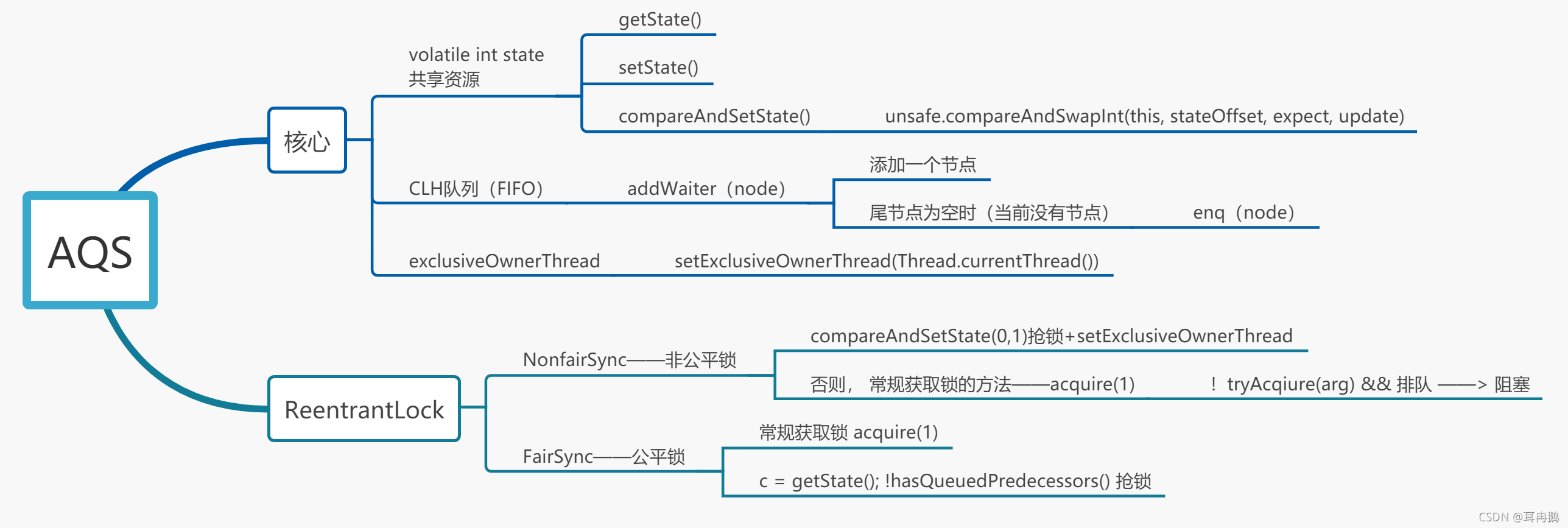当前位置:网站首页>【DIoU CIoU】DIoU和CIoU损失函数理解及代码实现
【DIoU CIoU】DIoU和CIoU损失函数理解及代码实现
2022-08-03 05:27:00 【寻找永不遗憾】
1 引言
目标检测任务的损失函数由Classificition Loss和Bounding Box Regeression Loss两部分构成。
Bounding Box Regression Loss Function的演进路线是:
Smooth L1 Loss --> IoU Loss --> GIoU Loss --> DIoU Loss --> CIoU Loss
之前写到了 Smooth L1 Loss 、 IoU Loss 和 GIoU Loss。
本文介绍DIoU Loss 和 CIoU Loss。
2 问题分析
GIoU Loss 存在的问题:
- 出现下图中的情况时,IoU和GIoU的值都一样,此时GIoU退化为IoU, 无法区分其相对位置关系。
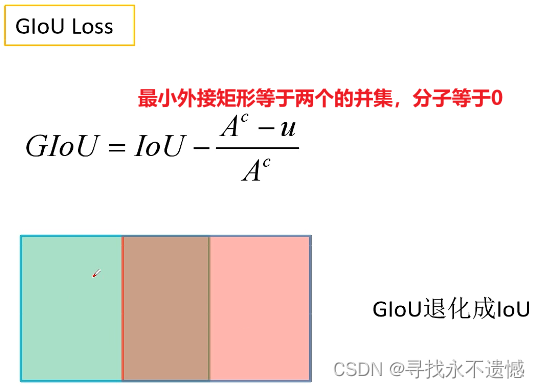
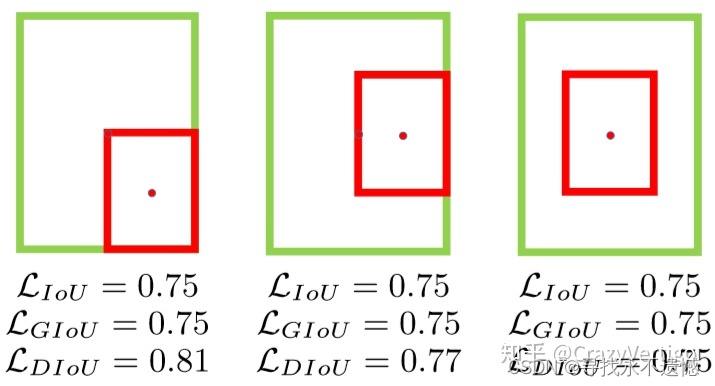
- 收敛的比较慢
- 回归的还不够准确
3 作者思考
基于IoU和GIoU存在的问题,作者提出了两个问题:
- 问题一:直接最小化预测框与目标框之间的归一化距离是否可行,以达到更快的收敛速度。
- 问题二:如何使回归在与目标框有重叠甚至包含时更准确、更快。
好的目标框回归损失应该考虑三个重要的几何因素:重叠面积,中心点距离,长宽比。
针对问题一,作者提出了DIoU Loss,相对于GIoU Loss收敛速度更快,DIoU Loss考虑了重叠面积(IoU)和中心点距离( d 2 c 2 \frac{d^{2}}{c^{2}} c2d2),但没有考虑到长宽比;
针对问题二,作者提出了CIoU Loss,其收敛的精度更高,以上三个因素都考虑到了。
4 DIoU Loss计算过程
Distance-IoU(DIoU) Loss计算过程如下: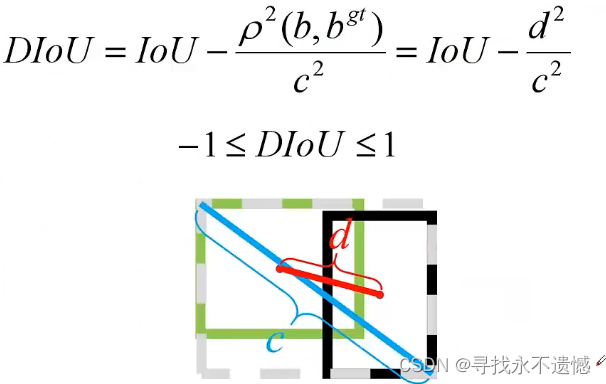
图中,b表示预测框中心点坐标, b g t b^{gt} bgt表示GT框中心点坐标。 ρ 2 ( b , b g t ) ρ^2(b, b^{gt}) ρ2(b,bgt)表示两中心点的距离的平方, c 2 c^2 c2表示两矩形最小外接矩形的对角线长度的平方。
DIoU损失能直接最小化两个box之间的距离,因此收敛速度更快。
L D I o U = 1 − D I o U L_{DIoU}=1-DIoU LDIoU=1−DIoU
当两个框重合时, L D I o U = 0 L_{DIoU}=0 LDIoU=0;当两个框相距无穷远时, L D I o U = 2 L_{DIoU}=2 LDIoU=2,故 0 ≤ L D I o U < 2 0≤L_{DIoU}<2 0≤LDIoU<2。
可以将DIoU替换IoU用于NMS算法当中,也即论文提出的DIoU-NMS, 实验结果表明有一定的提升。
DIoU相比于GIoU的优点:
DIoU Loss可以直接优化2个框之间的距离,比GIoU Loss收敛速度更快
对于目标框包裹预测框的情况,DIoU Loss可以收敛的很快,而GIoU Loss此时退化为IoU Loss收敛速度较慢
5 CIoU Loss计算过程
Complete-IoU(CIoU) Loss计算过程如下:在DIoU的基础上,考虑长宽比 α v αv αv。
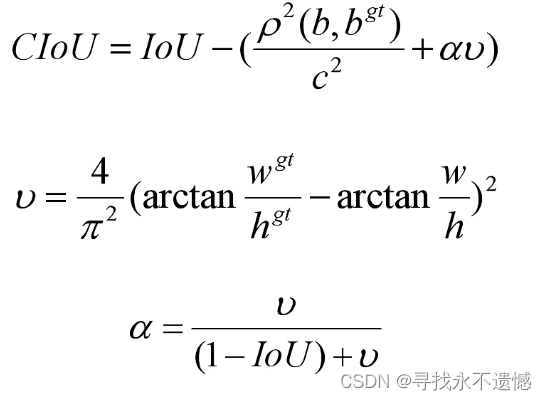
其中, α α α是用于做trade-off的参数, v v v是用来衡量长宽比一致性的参数。
CIoU Loss function的定义为
L C I o U = 1 − C I o U L_{CIoU}=1-CIoU LCIoU=1−CIoU
!注意!: CIoU loss的梯度类似于DIoU loss,但还要考虑 v v v的梯度。在长宽在 [0, 1] 的情况下, w 2 + h 2 w^2+h^2 w2+h2的值通常很小,会导致梯度爆炸,因此在 1 w 2 + h 2 \frac{1}{w^2+h^2} w2+h21实现时将替换成1。
6 IoU/GIoU/DIoU/CIoU代码实现可视化
import numpy as np
import cv2
import torch
import math
def CountIOU(RecA, RecB):
xA = max(RecA[0], RecB[0])
yA = max(RecA[1], RecB[1])
xB = min(RecA[2], RecB[2])
yB = min(RecA[3], RecB[3])
# 计算交集部分面积
interArea = max(0, xB - xA + 1) * max(0, yB - yA + 1)
# 计算预测值和真实值的面积
RecA_Area = (RecA[2] - RecA[0] + 1) * (RecA[3] - RecA[1] + 1)
RecB_Area = (RecB[2] - RecB[0] + 1) * (RecB[3] - RecB[1] + 1)
# 计算IOU
iou = interArea / float(RecA_Area + RecB_Area - interArea)
return iou
def Giou(rec1,rec2):
# 分别是矩形左上、右下的坐标
x1,y1,x2,y2 = rec1
x3,y3,x4,y4 = rec2
iou = CountIOU(rec1,rec2)
area_C = (max(x1,x2,x3,x4)-min(x1,x2,x3,x4))*(max(y1,y2,y3,y4)-min(y1,y2,y3,y4))
area_1 = (x2-x1)*(y1-y2)
area_2 = (x4-x3)*(y3-y4)
sum_area = area_1 + area_2
w1 = x2 - x1 #第一个矩形的宽
w2 = x4 - x3 #第二个矩形的宽
h1 = y1 - y2
h2 = y3 - y4
W = min(x1,x2,x3,x4)+w1+w2-max(x1,x2,x3,x4) # 交叉部分的宽
H = min(y1,y2,y3,y4)+h1+h2-max(y1,y2,y3,y4) # 交叉部分的高
# 交叉的面积
Area = W * H
# 两矩形并集的面积
add_area = sum_area - Area
# 闭包区域中不属于两个框的区域占闭包区域的比重
end_area = (area_C - add_area)/area_C
giou = iou - end_area
return giou
def Diou(bboxes1, bboxes2):
rows = bboxes1.shape[0]
cols = bboxes2.shape[0]
dious = torch.zeros((rows, cols))
if rows * cols == 0:#
return dious
exchange = False
if bboxes1.shape[0] > bboxes2.shape[0]:
bboxes1, bboxes2 = bboxes2, bboxes1
dious = torch.zeros((cols, rows))
exchange = True
# #xmin,ymin,xmax,ymax->[:,0],[:,1],[:,2],[:,3]
w1 = bboxes1[:, 2] - bboxes1[:, 0]
h1 = bboxes1[:, 3] - bboxes1[:, 1]
w2 = bboxes2[:, 2] - bboxes2[:, 0]
h2 = bboxes2[:, 3] - bboxes2[:, 1]
area1 = w1 * h1
area2 = w2 * h2
center_x1 = (bboxes1[:, 2] + bboxes1[:, 0]) / 2
center_y1 = (bboxes1[:, 3] + bboxes1[:, 1]) / 2
center_x2 = (bboxes2[:, 2] + bboxes2[:, 0]) / 2
center_y2 = (bboxes2[:, 3] + bboxes2[:, 1]) / 2
inter_max_xy = torch.min(bboxes1[:, 2:],bboxes2[:, 2:])
inter_min_xy = torch.max(bboxes1[:, :2],bboxes2[:, :2])
out_max_xy = torch.max(bboxes1[:, 2:],bboxes2[:, 2:])
out_min_xy = torch.min(bboxes1[:, :2],bboxes2[:, :2])
inter = torch.clamp((inter_max_xy - inter_min_xy), min=0)
inter_area = inter[:, 0] * inter[:, 1]
inter_diag = (center_x2 - center_x1)**2 + (center_y2 - center_y1)**2
outer = torch.clamp((out_max_xy - out_min_xy), min=0)
outer_diag = (outer[:, 0] ** 2) + (outer[:, 1] ** 2)
union = area1+area2-inter_area
dious = inter_area / union - (inter_diag) / outer_diag
dious = torch.clamp(dious,min=-1.0,max = 1.0)
if exchange:
dious = dious.T
return dious
def bbox_overlaps_ciou(bboxes1, bboxes2):
rows = bboxes1.shape[0]
cols = bboxes2.shape[0]
cious = torch.zeros((rows, cols))
if rows * cols == 0:
return cious
exchange = False
if bboxes1.shape[0] > bboxes2.shape[0]:
bboxes1, bboxes2 = bboxes2, bboxes1
cious = torch.zeros((cols, rows))
exchange = True
w1 = bboxes1[:, 2] - bboxes1[:, 0]
h1 = bboxes1[:, 3] - bboxes1[:, 1]
w2 = bboxes2[:, 2] - bboxes2[:, 0]
h2 = bboxes2[:, 3] - bboxes2[:, 1]
area1 = w1 * h1
area2 = w2 * h2
center_x1 = (bboxes1[:, 2] + bboxes1[:, 0]) / 2
center_y1 = (bboxes1[:, 3] + bboxes1[:, 1]) / 2
center_x2 = (bboxes2[:, 2] + bboxes2[:, 0]) / 2
center_y2 = (bboxes2[:, 3] + bboxes2[:, 1]) / 2
inter_max_xy = torch.min(bboxes1[:, 2:],bboxes2[:, 2:])
inter_min_xy = torch.max(bboxes1[:, :2],bboxes2[:, :2])
out_max_xy = torch.max(bboxes1[:, 2:],bboxes2[:, 2:])
out_min_xy = torch.min(bboxes1[:, :2],bboxes2[:, :2])
inter = torch.clamp((inter_max_xy - inter_min_xy), min=0)
inter_area = inter[:, 0] * inter[:, 1]
inter_diag = (center_x2 - center_x1)**2 + (center_y2 - center_y1)**2
outer = torch.clamp((out_max_xy - out_min_xy), min=0)
outer_diag = (outer[:, 0] ** 2) + (outer[:, 1] ** 2)
union = area1+area2-inter_area
u = (inter_diag) / outer_diag
iou = inter_area / union
with torch.no_grad():
arctan = torch.atan(w2 / h2) - torch.atan(w1 / h1)
v = (4 / (math.pi ** 2)) * torch.pow((torch.atan(w2 / h2) - torch.atan(w1 / h1)), 2)
S = 1 - iou
alpha = v / (S + v)
w_temp = 2 * w1
ar = (8 / (math.pi ** 2)) * arctan * ((w1 - w_temp) * h1)
cious = iou - (u + alpha * ar)
cious = torch.clamp(cious,min=-1.0,max = 1.0)
if exchange:
cious = cious.T
return cious
img = np.zeros((512,512,3), np.uint8)
img.fill(255)
# 分别是矩形左上、右下的坐标
RecA = [30,30,300,300]
RecB = [60,60,350,340]
cv2.rectangle(img, (RecA[0],RecA[1]), (RecA[2],RecA[3]), (0, 255, 0), 5)
cv2.rectangle(img, (RecB[0],RecB[1]), (RecB[2],RecB[3]), (255, 0, 0), 5)
IoU = CountIOU(RecA,RecB)
GIoU = Giou(RecA,RecB)
RecA_tensor,RecB_tensor = torch.tensor([RecA]), torch.tensor([RecB])
DIoU = Diou(RecA_tensor,RecB_tensor)
CIoU = bbox_overlaps_ciou(RecA_tensor,RecB_tensor)
font = cv2.FONT_HERSHEY_SIMPLEX
cv2.putText(img,"IOU = %.2f"%IoU,(130, 150),font,0.8,(0,0,0),2)
cv2.putText(img,"GIOU = %.2f"%GIoU,(130, 180),font,0.8,(0,0,0),2)
cv2.putText(img,"DIOU = %.2f"%DIoU,(130, 210),font,0.8,(0,0,0),2)
cv2.putText(img,"CIOU = %.2f"%CIoU,(130, 240),font,0.8,(0,0,0),2)
cv2.imshow("image",img)
cv2.waitKey()
cv2.destroyAllWindows()
结果输出: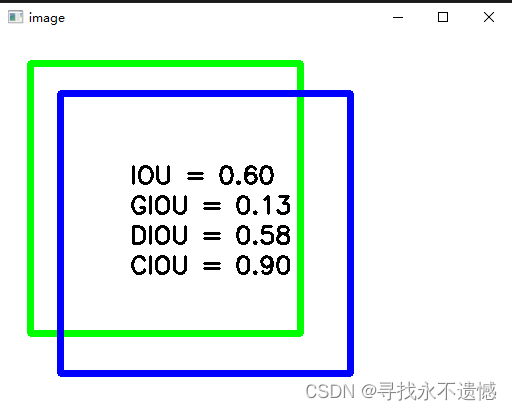
7 感谢链接
DIoU和CIOU用于目标检测与实例分割,作者已开源,可参考:
https://github.com/Zzh-tju?tab=repositories
其它感谢链接:
https://zhuanlan.zhihu.com/p/94799295
https://zhuanlan.zhihu.com/p/104236411
https://www.bilibili.com/video/BV1yi4y1g7ro?p=4
边栏推荐
猜你喜欢
随机推荐
数组与字符串10-实现 strStr()
数组与字符串13-两数之和等于目标数
ZBrush+Substance制作蜥蜴巫婆医生!
【记录】把json的所有key转换成小写
./autogen.sh: 4: ./autogen.sh: autoreconf: not found
Makefile.am:24: error: Libtool library used but ‘LIBTOOL‘ is undefined
【测试基础】bug分级、测试流程、ISO9126质量模型
零基础小白想往游戏建模方向发展,3D游戏建模好学嘛?
PHP二维数组保留键值去重
申请公网ip后,配置光猫,路由器使用公网ip步骤
2. What is the difference between Exception and Error?
各种cms getshell技巧
Nvidia NX使用向日葵远程桌面遇到的问题
VS2022 encapsulates static libraries and calls static libraries under window
笛卡尔积处理商品属性sku
Redis哨兵模式+过期策略、淘汰策略、读写策略
Oracle常用命令-基本命令
JUC并发编程深入浅出!
【C语言】输出100~200之间的素数/质数(3种方法)
TFS (Azure conversation) prohibit people checked out at the same time
